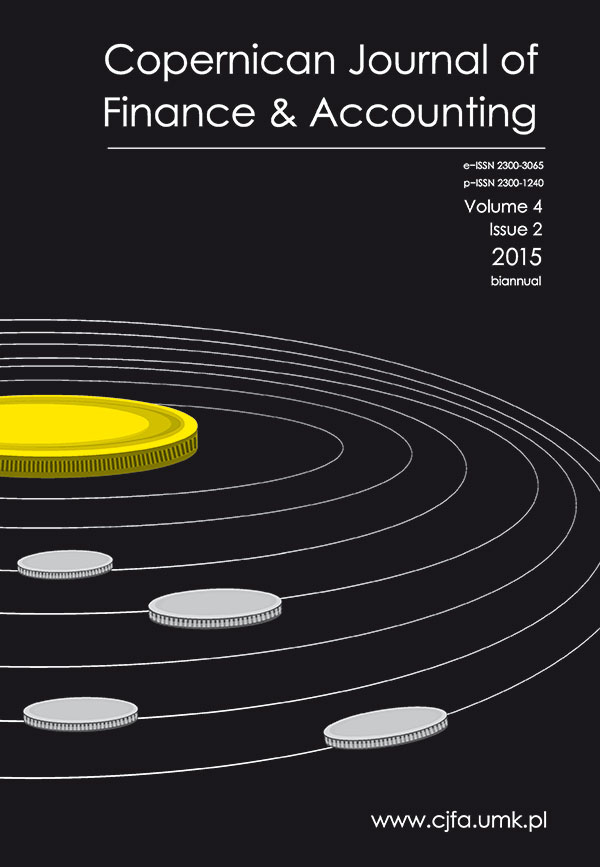The January seasonality and the performance of country-level value and momentum strategies
DOI:
https://doi.org/10.12775/CJFA.2015.024Ключові слова
January effect, turn-of-the-year effect, value, momentum, country-level anomalies, international investments, cross section of stock returns, asset pricingАнотація
The study examines the turn-of-the-year effect in the country-level value and momentum strategies. We re-examine eight distinct value and momentum strategies within 78 markets in the 1995‑2015 period and we test their performance for the seasonal patterns. We find that during the last 20 years the value strategies performed particularly well in January and poor in December. On the contrary, the momentum strategies had high returns in December and low in January. These observations are consistent with the explanations of the January seasonality related to the tax loss selling and window dressing effects.
Посилання
Asness, C.S., Liew, J.M., & Stevens, R.L. (1997). Parallels between the cross-sectional predictability of stock and country returns. Journal of Portfolio Management, 23, 79-87. http://dx.doi.org/10.3905/jpm.1997.409606.
Asness, C.S., Moskowitz, T.J., & Pedersen, L.H. (2013). Value and momentum everywhere. Journal of Finance, 68, 929-985. http://dx.doi.org/10.1111/jofi.12021.
Balvers, R. & Wu, Y. (2006). Momentum and mean reversion across national equity markets. Journal of Empirical Finance, 13, 24-48. http://dx.doi.org/10.1016/j.jempfin.2005.05.001.
Basu, S. (1983). The relationship between earnings yield, market value, and return for NYSE common stocks: further evidence. Journal of Financial Economics, 12, 129–156. http://dx.doi.org/10.1016/0304-405x(83)90031-4.
Bhojraj, S., & Swaminathan, B. (2006). Macromomentum: returns predictability in international equity indices. Journal of Business, 79, 429-451. http://dx.doi.
org/10.1086/497416.
Bouman, S., & Jacobsen, B. (2002). The halloween indicator, ‘sell in May and go away’: another puzzle. American Economic Review, 92(5), 1618-1635. http://dx.doi.org/10.1257/000282802762024683.
Carhart, M.M. (1997). On persistence in mutual fund performance. Journal of Finance, 52, 57-82.
Castro, F.H., & Schabek, T. (2014). ‘Sell not only in May’. Seasonal effects in emerging and developed markets. Available at SSRN: http://ssrn.com/abstract=2458515 or http://dx.doi.org/10.2139/ssrn.2458515 (accessed 24.06.2015).
Chen, H., & Singal, V. (2004). All things considered, taxes drive the January effect. Journal of Financial Research, 27(3), 351-372. http://dx.doi.org/10.1111/j.1475-6803.2004.00095.x.
Davis, J. (1994). The cross-section of realized stock returns: the pre-COMPUSTAT evidence, Journal of Finance, 49, 1579-1593. http://dx.doi.org/10.1111/j.1540-6261.1994.tb04773.x.
Fama, E.F., & French, K.R. (2008). Dissecting anomalies. Journal of Finance, 58, 1653–1678. http://dx.doi.org/10.1111/j.1540-6261.2008.01371.x.
Haugen, R.A., & Lakonishok, J. (1988). The incredible January effect: The stock market’s unsolved mystery. Dow Jones-Irwin, Homewood, IL.
Jacobs, H. (2015). What explains the dynamics of 100 anomalies? Journal of Banking & Finance, 57, 65-85. http://dx.doi.org/10.1016/j.jbankfin.2015.03.006.
Jegadeesh, N., & Titman, S. (1993). Returns to buying winners and selling losers: implications for stock market efficiency. Journal of Finance, 48, 65–91. doi: http://dx.doi.org/10.1111/j.1540-6261.1993.tb04702.x.
Keppler, M., Encinosa, P. (2011). The small-country effect revisited. Journal of Investing, 20, 99-103. http://dx.doi.org/10.3905/joi.2011.20.4.099.
Kim, D. (2012). Value premium across countries. Journal of Portfolio Management, 38, 75–86.
Lakonishok, J., Shleifer, A., Thaler, R., & Vishny, R. (1991). Window dressing by pension fund managers. American Economic Review, 81(2), 227–231. http://dx.doi.org/10.3386/w3617.
Litzenberg, R.H., & Ramaswamy, K. (1979). The effect of personal taxes and dividends on capital asset prices: theory and empirical evidence. Journal of Financial Economics, 7, 163-195. http://dx.doi.org/10.1016/0304-405x(79)90012-6.
Loughran, T. (1997). Book-to-market across firm size, exchange, and seasonality: is there an effect? Journal of Financial and Quantitative Analysis, 30, 607-618. http://dx.doi.org/10.2307/2331199.
Novy-Marx, R. (2012). Is momentum really momentum? Journal of Financial Economics 103, 429–453. http://dx.doi.org/10.1016/j.jbankfin.2014.10.002.
Paternoster, R., Brame, R., Mazerolle, P., & Piquero, A. (1998). Using the correct statistical test for the equality of regression coefficients. Criminology, 36(4), 859-866. http://dx.doi.org/10.1111/j.1745-9125.1998.tb01268.x.
Rosenberg, B., Reid, K., & Lanstein, R. (1985). Persuasive evidence of market inefficiency. Journal of Portfolio Management, 11, 9–16. http://dx.doi.org/10.3905/jpm.1985.409007.
Rozeff, M.S., & Kinney, W.R. (1976). Capital market seasonality: The case of stock returns. Journal of Financial Economics, 3, 379–402. http://dx.doi.org/10.1016/0304-405x(76)90028-3.
Sharpe, W.F. (1964). Capital asset prices: a theory of market equilibrium under conditions of risk. Journal of Finance, 19, 425-442. http://dx.doi.org/10.2307/2977928.
Yao, Y. (2012). Momentum, contrarian, and the January seasonality. Journal of Banking and Finance 36, 2757-2769. http://dx.doi.org/10.1016/j.jbankfin.2011.12.004.
Zaremba, A. (2015a). Country selection strategies based on value, size and momentum.
Investment Analyst Journal, 44(3), 171-198. http://dx.doi.org/10.1080/10293523.2
1060747.
Zaremba, A. (2015b). Momentum and low-volatility effects in country-level stock market anomalies. Available at SSRN: http://ssrn.com/abstract=2621236 (accessed: 25.06. 2015).
Zaremba, A., & Konieczka, P. (2015). Do quantitative country selection strategies really work? Available at SSRN: http://ssrn.com/abstract=2606178 or http://dx.doi.org/10.2139/ssrn.2606178 (accessed 25.06.2015).
Downloads
Опубліковано
Як цитувати
Номер
Розділ
Stats
Number of views and downloads: 788
Number of citations: 0



